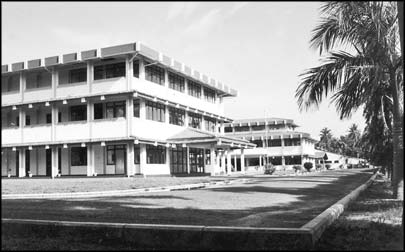Technical education in Sri Lanka
| Speech by
Higher Education Minister Prof. Wiswa
Warnapala at the
inauguration of the Project for the Enhancement of Technical
Education assisted by
Austria and
The Netherlands in Colombo
on February 2. |
In the period of colonial rule, the policy was to encourage
scholastic education through an elite oriented university which, in
keeping with the policy of limiting education to a privileged few,
adopted a restrictive admission policy with which it produced a class of
men who manned the administrative and professional services.
 |
|
Prof. Wiswa
Warnapala |
In the sphere of technical education, though a Technical College was
established in 1893 as an institution attached to the Department of
Education, no much attention was paid to the expansion of this
institution. It began with 25 students for whom a small workshop,
laboratory and classrooms were provided in a building close to the
railway station at Maradana, Colombo.
Science Education
This institution, which then was known as the Ceylon Technical
School, was entrusted with multiple services; in fact, it had to
undertake the training of Science teachers as well. It, in a way, became
the nucleus of a centre for science education.
The Government Technical School, therefore, operated on the basis of
the limited colonial objectives, and it was re-named as the Ceylon
Technical College in 1906, and it, since then, functioned as the main
institution which produced the trained and skilled personnel
requirements of such Technical Departments as the Railway, Irrigation
and Public Works.
In the twenties, especially with the establishment of the University
College in 1921 as a colonial higher educational institution, certain
significant changes took place in the field of higher education, and
they had an impact on the teaching of both science and engineering
oriented courses.
Higher Education
It was on the basis of this strategy and policy that the Ceylon
Technical College began to teach such subjects as engineering,
telegraphy, surveying, chemistry and physics.
It, throughout this period in which there was a major debate in the
country on the need to expand higher educational opportunities and this
debate, though in the hands of the English educated upper middle class,
generated a highly intellectual type of discussion, which eventually
paved the way for some reorganisation, the major element of which was
the preparing of students for external degrees in Engineering of the
University of London.
The development of the Ceylon Technical College became lop-sided
because it functioned as a Government Department which came under the
purview of members of the colonial bureaucracy, and they, as expected,
never thought in terms of economic and social development of the
country; they were interested only in the maintenance of law and order.
It was with the establishment of the fully independent and autonomous
University of Ceylon in 1942 that the need was felt for the creation of
a Faculty of Engineering in 1951, and it was with this landmark change
that the country began to produce engineers.
The technical education sector, which, in fact, was subordinate to
the University sector, evolved into a highly fragmented sector with a
network of Technical Colleges specialising in craft and trade courses.
There were separate institutions, specialising in some kind of
technical education, and they operated under different
development-oriented Ministries; they conducted more than 3,000
technical and vocational training programmes.
The lack of co-ordination and the failure to establish specific
objectives led to so much confusion that this sector, to a great extent,
remained dysfunctional. Most institutions conducted both Diploma and
lower level courses, and it was through this scheme that additional
opportunities were created for the secondary-school leavers who could
not find places within the conventional university system.
Employment-Oriented
The lowest level in the structure of the tertiary education, for
which the entry qualification was the GCE Ordinary Level, and the
courses were largely employment-oriented.
Though such structures came to be established in response to tackle
the unemployment of the youth, no institutions were established to
produce employable skills and the production of skills required for the
economic development of the country.
 |
|
Technical
Training Institute Katunayake |
During the seventies and eighties that the traditional view of higher
education began to change; higher education was seen as designed
primarily to develop and transmit academic knowledge.
Most developing countries wanted to break-away from this tradition
and began to emphasize the need for a special category of professionals
with specific training, and such professionals were called the higher
level technicians; he is not simply a skilled worker.
In other words, the country wanted to produce a higher level
technicians who has both skilled worker qualifications and the knowledge
required of a technician. Such technicians should have both scientific
and technical knowledge that could be used for development.
The emphasis was on a specific education that represented an
intermediate level between the engineer and the specialised worker, and
therefore, a specific system of education had to be devised to meet the
demand for training which up to his time was unheard of in higher
education.
Technological Knowledge
This type of education, which we propose to impart through the SLIATE,
was technology-oriented, and it was closely linked to the development of
scientific and technological knowledge in the modern world.
The higher level technicians, whom we produce through the SLIATE,
must be capable of mastering how to use a machine or a technological
tool; they must have sufficient technological knowledge as well as
adequate expertise to be able to make optimum use of the equipment.
In other words, aim was to produce technicians with skills based more
solid technological knowledge so that such a trained person would also
facilitate adaptation to change.
Yet another factor was the need to respond to the evolving demands of
the economy; the needs of the productive sectors of the economy need to
be taken into consideration. |





